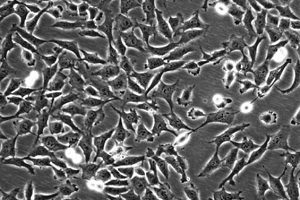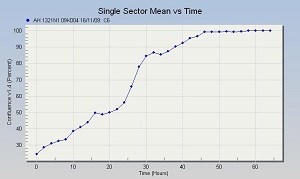Cell Line Profile 1321N1
(ECACC Catalogue no. 86030402)
Cell line history
1321N1 cells were derived from a sub clone of the cell line 1181N1, which in turn was derived from U-118MG a line isolated from a human malignant glioma. The STR profile of 1321N1 is similar to that of U-118MG, a glioblastoma.
Key characteristics
The cell line expresses surface receptors for regulation of cell migration. Studies of regulators of growth and migration show that mutation of the enzymes that modify these regulators, are linked to changes in the cell invasion and metastasis. They are also associated with various pathological syndromes e.g. Lowe syndrome.

Image showing 1321N1 cells
Applications
This line in conjunction with other glioma derived lines has been used in studies into neurological disease including the effects of neurotropic factors, transmembrane transport, drug delivery and degenerative diseases e.g. Alzheimer’s. Glial cells are now known to interact with neurons and are involved in their repair and the recycling of neurotransmitters. Cells communicate by releasing the messenger molecule IP3, a phospholipid, which produces a calcium ‘wave’, which in turn triggers the release of ATP, acting as a signal messenger between cells. 1321N1 cells have been shown to express both the M3 and M5 receptors for muscarine, which form G-protein receptor complexes, known to be involved in disorders in smooth muscle and the CNS.
Culture tips
The cells are relatively straightforward to culture, producing a typical neuronal morphology in culture i.e. interlinking bipolar cells as the cell density increases. They grow in DMEM + 10%FBS and a normally seeded at a starting density of approx. 2x104 cells/cm2. Cells should be sub cultured when they reach a maximum of 90% confluence.
Growth Profile

1321N1 Growth profile
|
Related cell lines |
ECACC catalogue number |
|---|---|
|
MOG-G-CCM |
|
|
MOG-G-UVW |
|
|
U-373 MG (Uppsala) |
|
|
U-87MG |
Key references
Macintyre EH, Pontén J, Vatter AE. 1972 The ultrastructure of human and murine astrocytes and of human fibroblasts in culture. Acta Pathol Microbiol Scand A. 80(2):267-83.
Barretina J, et al., 2012 The Cancer Cell Line Encyclopaedia enables predictive modelling of anticancer drug sensitivity. Nature. 483(7391):603-7
William's Elong et al., 2016 SHIP2 controls plasma membrane PI(4,5)P2 thereby participating in the control of cell migration in 1321 N1 glioblastoma cells. J Cell Sci 129: 1101-1114
Paul C. Guest, Keiko Iwata, Takahiro A. Kato , Johann Steiner. MK-801 treatment affects glycolysis in oligodendrocytes more than in astrocytes and neuronal cells: insights for schizophrenia. Cell. Neurosci., 12 May 2015.
Edward Burnett, Simon Lydford, Diane Fellows, James Taylor and James Cooper - Molecular Identification and Pharmacological Characterisation of the Co-expression of M3 and M5 Muscarinic Receptors on the Human Astrocytoma Cell Line 1321N1. 2011. Click here to download poster
